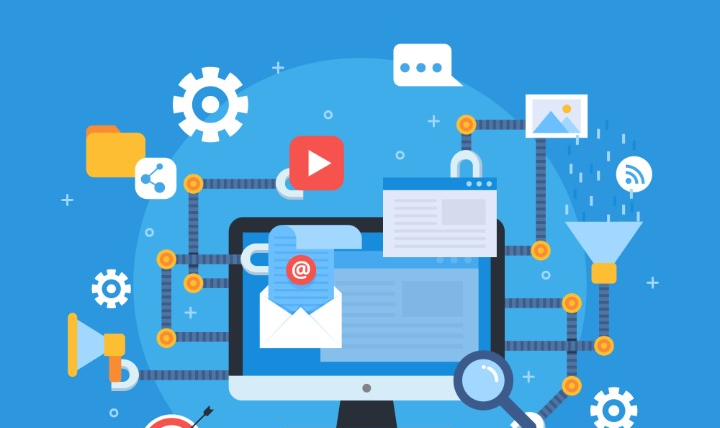An e-commerce business is an entity that facilitates commercial transactions over the internet, especially through a website or mobile devices. Operating online, the e-commerce business allows consumers to browse and purchase products or services without having to visit a physical store. The essence of an e-commerce business is to leverage digital technologies to offer convenience, variety, and competitive pricing while also utilizing data and analytics to continuously optimize offerings and operations in a dynamic, competitive environment.
According to Shopify, the global e-commerce market is valued at $6.3 trillion, with the US e-commerce market forecasted to reach more than $940.9 billion in 2023. E-commerce businesses operate in various models, like B2C, B2B, C2C, and C2B. By some estimates, there are approximately 26 million e-commerce websites globally. Some e-commerce platforms, such as Amazon, eBay, Alibaba, and Flipkart, operate mainly online, while other businesses use online platforms as an extension of their physical presence, like Walmart and BestBuy.
A typical e-commerce website provides consumers access to a wide variety of products or services through a website or a mobile app. It showcases a catalog of goods or services, providing detailed product or service information to enable consumers to make a purchase in just a few clicks and receive their orders at their preferred location. Behind the scenes, businesses use a variety of technologies and systems, including order processing, payment processing, and inventory management, to provide a seamless user experience.
Modern e-commerce websites are transformative, providing personalized shopping experiences. However, if you’re launching or thinking about starting an e-commerce business, then here are some of the essential features that your website must have.
- Single-product or multi-product layout
- Responsive Design
- Product listing and detail page
- Product images and videos
- Discounts and promotions
- Customer Reviews and Ratings
- Shopping Cart and Checkout process
- Payment Gateway Integration
- Chatbot
- On-Page SEO
- Social Media Marketplace integration
- Analytics and Reporting
Web Design
E-commerce web design is centered around crafting user-friendly, efficient, and engaging online stores. The design elements should incorporate your brand identity, mobile responsive, and optimized for search engines to drive traffic and generate interest. Below are some of the key e-commerce web design features that are applicable for any e-commerce site.
E-Commerce Layout and Theme
As previously highlighted, the e-commerce landscape is diverse, with various business models such as C2C and B2B, and it encompasses a wide range of products and services. Some businesses may specialize in a single product, while others offer an extensive array of items.
There are many standards evolved, and choosing an appropriate theme and layout is pivotal as it greatly influences the user experience, aesthetic appeal, and functionality of your online store. For instance, A single-product e-commerce theme focuses on presenting one central product, emphasizing its features, benefits, and call-to-action, whereas a multi-product theme is structured to showcase a variety of products, allowing customers to explore a range of items. It’s essential that the chosen theme and layout not only resonate with your brand identity and values but are also intuitive, user-friendly, and ensure easy navigation and quick loading, simplifying the process of finding and ordering your products or services fast and easy.

Responsive Design
A responsive design ensures that your e-commerce website is optimized for various devices, including desktops, smartphones, and tablets. The importance of having a responsive e-commerce website is paramount, as customers are increasingly using their mobile devices for shopping. According to Statista’s Market Insights, mobile e-commerce accounted for 60 percent of all e-commerce transactions in 2023. Additionally, Google’s search engine algorithm prioritizes mobile-friendly websites, implicating responsive design in improved search engine rankings and, consequently, increased online visibility. In an environment where user experience influences purchasing decisions and brand perception, a responsive design is not merely advantageous but indispensable for e-commerce businesses aspiring to capture and retain the evolving consumer base.

Product Catalog
A product catalog is a structured collection of items available for purchase, showcasing the store’s inventory, usually consisting of product images, descriptions, and specifications. A good product catalog should help your site visitors find the right products or services, and make the transaction easier.
Product listing and detail page
A product catalog features two main components: the product listings and the detail page
The product listing serves as an overview of the products available for purchase. It organizes products into different categories and subcategories, facilitating effortless navigation for your site visitors across different product tiers. Typically, this page offers various views of the product catalog, such as list view and gallery view, to accommodate different user preferences. Especially for e-commerce businesses with a large product catalog, it’s imperative to have search and filter capabilities.
Conversely, a product page delves into the specifics of a product or service, typically encompassing product images, descriptions, prices, and specifications. A well-designed product page should present high-quality, clear, and accurate images, offering a true-to-life representation of the products. The integration of precise details about product availability, pricing, and variations significantly optimizes user experience, empowering potential buyers to make informed purchase decisions.
High-Quality Product Images and Videos
Unlike in-store shopping, where customers can touch and feel products, achieving the same experience is challenging online. Therefore, high-quality product images and videos are crucial for simulating similar experiences virtually. An effective product detail page should enable customers to view products from multiple angles, observe intricate details, and witness the product in action, all contributing to more informed purchasing decisions. Clear, high-resolution images, coupled with well-produced videos, can alleviate uncertainties and address potential questions customers might have about the product, subsequently enhancing conversion rates and diminishing return rates.
Discounts and Promotions
If you’re selling a new product, or a new business, you may need to run promotions to attract and retain customers. To do this, your online store must have the capability to support discounts and promotions. Ensure your website has options to create, manage, and monitor various promotional activities like discount codes, seasonal sales, and loyalty programs, encouraging repeat purchases and enhancing customer loyalty.
Customer Reviews and Testimonials
Customer reviews and testimonials play a pivotal role in establishing trust and aiding users in their purchasing decisions. This feature offers prospective buyers valuable insights into product quality and performance based on the experiences of previous purchasers and can significantly impact conversion rates.
If you’re operating a service-based business, featuring testimonials is invaluable for building trust and fostering relationships with your customers.
If you’re starting out new and do not have any customer reviews or testimonials, you may need to focus on building the reviews or testimonials through discounts and promotions.
Order Processing
Order processing is one of the key components of e-commerce operations, ensuring customer orders are processed appropriately. Once a customer places an order, the order processing process collects appropriate payments, confirms the purchase and initiates the process to order delivery and shipping. Efficient order processing is essential to meet customer expectations, manage inventory effectively, and ensure the overall smooth running of an e-commerce business. Below are some of the essential features of order processing.
Shopping Cart and Checkout Process
The shopping cart and checkout process are part of the order processing, serving as the final steps in a customer’s purchasing journey. In the shopping cart, customers review their selected items, make modifications if needed, and proceed to checkout. During checkout, customers fill in shipping details, choose a payment method, and make the payment. It’s vital that this process is user-friendly and secure, offering multiple payment options and clear pricing, to facilitate a smooth and trustworthy transaction, ensuring customers feel confident in completing their purchases and returning for future business.
Secure Payment Gateway
A secure payment gateway is a crucial part of payment processing, facilitating the authorization of online transactions. A secure payment gateway includes encryption of transaction details, user authentication, and secure transmission of data, essential for maintaining customer trust and safeguarding against unauthorized access and data breaches. The transaction should adhere to PCI compliance, security standards designed to protect card information during and after a financial transaction. Many e-commerce platforms provide out of the box secure payment gateways. You can also integrate with third-party payment gateways such as PayPal and Stripe, which does most of the work for you.
Marketing, Sales, and Support Features
Businesses operate with the fundamental goals of generating revenue and securing profits. Effective marketing, sales, and support are crucial in drawing in, converting, and retaining customers. While outbound marketing might be essential to attract customers, here are some of the built-in features within websites that can effectively complement other marketing and sales efforts.
Chatbot
A chatbot is essential for providing immediate, automated interaction, and support to visitors. This feature assists users in finding products, answering queries, and resolving issues, significantly enhancing the user experience by offering real-time responses. Chatbots can handle multiple customer interactions simultaneously, ensuring that user inquiries are addressed promptly, which is especially valuable during peak traffic times. By providing instant support and interaction, chatbots can improve customer satisfaction, increase conversion rates, and reduce the workload on customer support activities, thus allowing them to focus on more complex tasks and inquiries. An AI enabled chatbot can even help you open your online store 24 * 7.
Social Media Marketplace Integration
Integrating with social media marketplaces is a critical feature for e-commerce websites to extend their reach and visibility. This feature enables businesses to list and sell products directly through social media platforms, such as Facebook Marketplace or Instagram Shopping, tapping into a broader audience base. It also facilitates seamless interaction with customers through social media channels, allowing businesses to engage with their audience, gather feedback, and address queries and concerns effectively. Integration with social media marketplaces can significantly amplify your brand’s presence and boost sales by providing users with multiple avenues to discover and purchase products. The social media marketplace integration can be beneficial, especially when you’re launching a new product or starting out new.
Analytics and Reporting
Measuring is key for improvements. Your website analytics and reporting are indispensable tools for understanding user behavior and improving site performance. Integrating platforms like Google Analytics is essential as it provides detailed insights into user interactions, traffic sources, and conversion rates, enabling businesses to make informed, data-driven decisions. Key features often include real-time analytics, conversion tracking, and user behavior analysis, all vital for optimizing the user experience and enhancing the effectiveness of marketing strategies. These insights allow you to identify trends, monitor performance, and make continuous improvements in achieving your business objectives.
Summary
In summary, e-commerce websites are pivotal assets in conducting successful online business. Launching a comprehensive website with many bells and whistles can be intricate and costly, but starting with core features and evolving progressively is often the most prudent approach for new businesses.
Starting with a responsive, user-friendly design is fundamental for adaptive, seamless user experiences across varying devices. Incorporating high-quality product visuals and detailed information accelerates buying decisions, while the integration of secure, diverse payment gateways solidifies user trust and enhances transaction likelihood. The inclusion of key marketing features from inception enables immediate engagement and nurturance of prospective customers. Additionally, integrating analytical tools like Google Analytics furnishes actionable insights, enabling continuous optimization of both user experience and business growth. We wish you prosperity in building a thriving e-commerce business. For e-commerce talent and solutions, feel free to explore the e-commerce services offered by Minutly.








How to launch your web application development service
Website with a purpose: How to drive quality website traffic?
How to start a Generative AI Service: A Comprehensive Guide (2024)
How to launch your web design service – A comprehensive guide to success
What is a Service Catalog?
Top 10 Essential Sales Service Requests Every Business Should Offer
Sharing your Minutly Catalog
Setting up your catalog